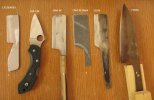I had way too many dry-shave with edges off this strop - with result from great to pain. So I made a few straight razors and see this strop's limits
 * inclusive degree
* inclusive degree
1. AEB-L (razor/surgical stainless ~60rc) : my current go to razor
a. 12*, 15*, 22* => burrs = failed
b. 22* (progression 1K, 4K, 8K waterstones 1,0.5,0.25,0.1um diamond paper stones all in edge-leading strokes, bare leather) => clean smooth dry shave better than disposable 3 blade razors. I will regrind this to lower angle for testing later.
2. ZDP-189 dragonfly (66rc): was my primary shaver for awhile until demoted
a. 14* => burrs
b. 18* => clean
3. CPM 3V (~60rc)
a. 10*, 15* => burrs
b. 20*+ => clean
4. CPM 3V blank - waiting for my Evenheat KO HT oven to arrive then will compare this edge vs #3 (which ht by a brick forge & gas cooking burner)
5. 52100 (~60rc): steel was all pitted-up before I made this razor but I did it anyway to test.
a. 10*+ => clean. It would has been usable if the edge was pits free.
6. 15N20 (~58rc): A 10.5cm petty. yeah, I test knives to find performance boundaries too
a. 8* to 20* => clean shave & slice/push phonebook paper. Rolled when make 2-3mm thick shavings from pine board
b. 26* => clean shave & no roll on cardboard, pine shaving, chop hard vegies.
For me, burrs or wire-edge = failed for this combination (blade steel + ht + this strop + angle).
So this strop is quite versatile for majority of practical non-facial-shaving edges.


